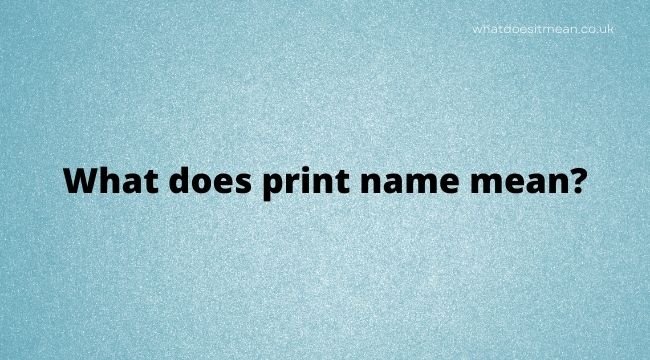
What does print name mean?
Have you ever glanced at someone’s signature, whether on a new law or a critical document and noticed that the words “Printed name” were located near their signature?
On this day, we’ll look at what the term “printed name” means, when you could encounter it, why it would be necessary, and how it might be composed.
What does print name mean?
The “printed name” refers to the person’s name who will be signing the document. It will be typed out, generally by a computer, in order for people to be able to understand it correctly.
Our autographs are often sloppy and difficult to read most of the time. As a result, having the “print name” makes it easier to determine who the signature belongs to in the first place.
The purpose of signing a document
First and foremost, let us consider what a signature is intended to do. What is the purpose of having them? What is the function of these objects?
When you sign something, you are entering into a legal contract. The signature confirms that you have read and comprehend the content, as well as that you agree to the terms set out in it. And in order to enter into a legally enforceable agreement, you must be aware of what it is that you agree to.
Essentially, signing a paper is your way of stating, “I have read this document and agree to follow the instructions contained within it.”
What is the purpose of the printed name?
And after all, if you’re going to sign anything anyhow, why is it necessary for it to include your name?
The first reason is that you will be able to tell where to sign when you arrive. So, for example, John Smith will know to mark where it reads “signature” if you see “Printed Name: John Smith” on the document.
It also makes it crystal evident who signed the document.
Someone who is interested in finding out who signed a specific contract will be able to glance at the written name and see that it was John Smith who signed the contract in question.
All of this only serves to emphasize the fact that everything is exactly how it should be.
Why is it necessary to have a printed name next to a signature?
You might be wondering why our signatures are so dreadful in the first place.
The first reason is that many of us were taught to write in “cursive,” which is cursive writing. Coca-typeface Cola’s is seen here. Generally speaking, this type of writing isn’t the most enjoyable to read.
Second, since we write our names so frequently, we get increasingly adept at doing so quicker and faster until we can do it without thinking. Alternatively, it might be because we don’t handwrite nearly as often as we used to.
Many of us write in the complicated and difficult-to-read script to make our signatures look posher.
Whatever the cause, the reality remains that signatures can be difficult to decipher for a variety of reasons.
There are several different ways to write a written name.
There are various distinct methods to write a printed name, and each one has its own advantages. For example, your first and last names may be John Smith, and your middle name could be Smith.
You could be known by a given title and surname, Mr. Smith.
To identify yourself, you might also use a title, the initial letter of the first name, and the surname, such as Mr. J. Smith.
In rare situations, the initial letter of the first name and the first letter of the surname might be the same- J. Smith.
You might even use the whole title, first name, middle name, and surname, such as Mr. John Taylor Smith, as your title and first name.
These variations pertain to the same individual, and they all fulfill the same function.
Printed name as opposed to the print name
Along with the words “printed name,” you may also notice the words “print name,” and there is a distinction between the terms “printed name” and “print name.”
While the “printed name” is often written by a machine, the “print name” is filled out by the individual signing the documents.
“Print name” refers to your name written in all capital letters on a piece of paper. Typically, this will be on documents that anybody may fill out, and as a result, they will not have your “printed name” put on them as you would expect. The use of capital letters makes it easier for others to recognize your name while you’re writing it.
Phrases contain the phrase “printed name”:
– “Stupid people recorded themselves coercing a public figure into signing something under duress, and they were under the impression that their restaurant napkin document wouldn’t have any legal weight if it didn’t have their Printed Name and Date on it.”
– “I guess the thing that annoys me the most is that the Yankees jersey has a printed name on the back.”
“Shawn, did you notice that the description states that the name and numbers are screen printed?”
Conclusion
What does print name mean? And now you’re aware of what the “printed name” refers to.
When a form specifies “printed name,” it means that the information will be written out on a computer and that there will be another line for you to sign your name next to it.
The written name identifies the individual who has signed the form and specifies who the form was meant for.
If you ever need to sign a contract and come across the phrase “printed name” and are a little unsure of what it means, the information in this article could be helpful to you.


